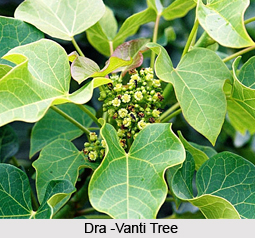 Dra-vanti is a large soft-wooded shrub, cultivated throughout India as an oil-yielding plant. The plant can reach up to 6 m of height and has the botanical name of Jatropha curcas L. Dra-vanti is actually the Sanskrit name of this plant and it is known as curcas nut and physic-tree nut in English. The plant has many names in different Indian languages. The Hindi names of the plant are bagbherenda, chandarjot, jangliarand, rajanjot or safed arand and in Bengali; it is known as bagbherenda or erandagachh. The Gujarati speaking people know the plant as jamalgota and ratanjota and in Kannada; it is popular as adaluharalu, bettada haralu, dodda haralu, karnocchi or marahar-alu. The Tamil names of Dra-vanti include kadalamanakku, kaitta, kattamanakku, kuribaravuni and vellaiyamanakku, while the Telugu speaking people call it as adaviamidamu, katiyamudamu, napalamu or peddanepalamu.
Dra-vanti is a large soft-wooded shrub, cultivated throughout India as an oil-yielding plant. The plant can reach up to 6 m of height and has the botanical name of Jatropha curcas L. Dra-vanti is actually the Sanskrit name of this plant and it is known as curcas nut and physic-tree nut in English. The plant has many names in different Indian languages. The Hindi names of the plant are bagbherenda, chandarjot, jangliarand, rajanjot or safed arand and in Bengali; it is known as bagbherenda or erandagachh. The Gujarati speaking people know the plant as jamalgota and ratanjota and in Kannada; it is popular as adaluharalu, bettada haralu, dodda haralu, karnocchi or marahar-alu. The Tamil names of Dra-vanti include kadalamanakku, kaitta, kattamanakku, kuribaravuni and vellaiyamanakku, while the Telugu speaking people call it as adaviamidamu, katiyamudamu, napalamu or peddanepalamu.
Dra-vanti is found quite extensively in various parts of India and is mostly grown as a hedge plant or field barrier. The plant is often naturalised in the surrounding area of Indian villages in open, disturbed habitats, commonly in wastelands. In central India, the plant usually flowers between the months of July and September and fruits from October to December. The plant remains leafless between December-January and May-June, in this region. However, Dra-vanti is not a native to India and was brought as an oil-yielding plant probably by the Portuguese. The origin of the plant is in tropical America and Mexico and the tentative time of its arrival in India is the European colonial period.
Dra-vanti has a fairly shiny and peeling bark and also a sticky and opalescent sap. The alternate leaves of the plant are generally ovate. The plant`s flowers are of yellowish-green colour. The flowers are located in loose axillary cymose panicles. The peduncles and pedicels of Dra-vanti are more or less tomentose and the 1 cm long bracts are linear. The male flowers of the plant have a 3.8 mm long calyx and elliptic and obtuse lobes. The campanulate and yellowish corolla of these flowers is longer than the calyx and is hairy within. It has 5 lobes. On the other hand, the female flowers of Dra-vanti have a 5 mm long calyx and their lobes are ovate and acute. Their corolla has almost the same length as the calyx. The plant`s ovoid fruit has a length of 2.5 cm and it turns black when ripe. It also breaks into three 2-valved cocci and contains 1.8 cm long ovoid-oblong seeds that are dull brownish-black in colour.
Several medicinal properties and uses of Dra-vanti have been discovered so far. The plant is used frequently in various traditional Indian medicines. According to the Ayurvedic medicine, the fruit and the seed of the plant are astringent and anthelmintic and can help for treating chronic dysentery, urinary discharges, biliousness, anaemia, fistula and heart diseases. The leaves of the plant are considered rubefacient and lactagogue. The leaf juice is frequently applied externally to stop bleeding from wounds, ulcers and cuts, and also to relieve piles. The leaf juice is reported to have insecticidal properties as well. The tender twigs of the plant are used for cleaning teeth and the juice is also reported to relieve toothache and strengthen gums. The latex exuded from the plant is considered effective for treating scabies, eczema and ringworm, if applied externally. The latex can also aid in the healing of boils and foot sores. The people in southern Orissa internally take the latex along with ripe banana for treating dysentery in adults.
The sap collected from the twigs of Dra-vanti is considered astringent and is commonly used for dressing wounds and ulcers. In the Konkan region in Maharashtra, the bark of the plant is taken internally, after being rubbed with asafoetida and buttermilk for getting relief from dyspepsia and diarrhoea. A decoction of the bark is also used externally in treatment of rheumatism and leprosy. The tribal inhabitants of southern Andhra Pradesh use another decoction of the root bark to rinse the mouth to relieve toothache and sore throat. A paste made from the plant`s root bark is used externally to promote the healing of sores, swellings and eczema as well. However, one should be careful while using the fruit, seeds and seed oil of the plant, as the seeds are considered a violent purgative and are also known to be poisonous.



















